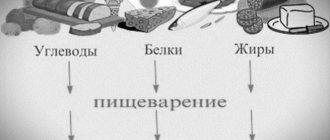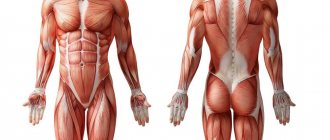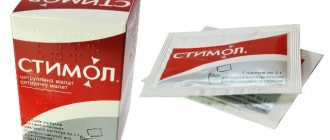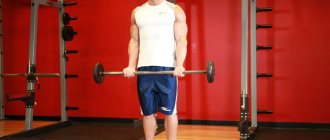A little physiology: where does pain come from?
Flowchart of how lactic acid is formed
Working in the gym with iron refers to those types of muscle activity that go beyond optimal limits and are stressful. In such cases, the body turns on emergency cell energy supply systems.
Read more about all the ways to eliminate muscle pain after training:
Normal physical activity on muscles does not exceed 50% of the possible maximum tension. Energy nutrition of cells in this mode occurs due to the breakdown of fats with an increased supply of oxygen to working areas of the body.
Strength exercises with weights go beyond the 50 percent threshold of maximum loads. During such work, the muscles become extremely tense; their strong contraction prevents the cells from being saturated with blood and oxygen. Pictured: Kai Greene
The heart muscle, working to the limit, does not have time to pump blood to the affected areas; it itself experiences oxygen starvation.
Under such conditions, the body transitions to anaerobic (oxygen-free) metabolism. Cells receive energy resources as a result of glycolysis: the breakdown of glucose into 2 organic acids.
- ATP (adenosine triphosphate) is absorbed by cells and provides energy for all biochemical processes in the body.
- Lactic acid, the second product of glycolysis, cannot leave the muscle fibers through the bloodstream during intense exercise and is forced to accumulate in them.
- The retention of lactic acid in the muscles leads to its decomposition into lactate and hydrogen ions.
Lactic acid content in blood
The more ATP the cells receive, the longer the body can work at increased intensity. The stress regime of energy supply ensures that muscles work at maximum loads, but is accompanied by the accumulation of lactic acid in them.
Cellular respiration for energy
To obtain energy, the cell “breathes” and such breathing has the purpose of producing energy molecules (ATP or adenosine triphosphate), with the help of which the cell can carry out all processes that require energy.
Differences between aerobic and anaerobic cellular respiration
Our cells use two types of respiration: aerobic and anaerobic.
- The process of aerobic respiration occurs using oxygen. As a result of this process, carbon dioxide and water (CO2 and H2O) are formed. Oxygen in this case is the “ultimate acceptor” of electrons.
- Anaerobic respiration occurs without oxygen and results in the formation of lactic acid.
There are different types of anaerobic respiration in nature, but we humans use “anaerobic glycolysis” or “lactic acid fermentation” . This type of anaerobic respiration produces energy from glucose , but produces lactic acid , which is used to ingest e-waste to avoid problems.
As we see, these types of respiration form different metabolites , but this is not the only difference; their efficiency also differs: in the case of lactic acid fermentation (anaerobic), 2 ATP molecules are formed, and aerobic fermentation produces 38! This is the main reason why we cannot remain without oxygen for a long time.
Lactic acid even at rest
Why do cells perform anaerobic processes even in the presence of oxygen ?
The fact is that this type of respiration, producing ATP, allows you to instantly satisfy energy demands , while aerobic processes require time.
When we load our muscles, anaerobic respiration tends to compensate for the sharply increased need for energy , but aerobic processes do not come into full force.
It should also be taken into account that muscles consist of different fibers:
- The white fibers, although initially weak, begin to work as soon as you begin to move, producing abundant lactic acid.
- The red fibers adjacent to the white fibers “perceive” the increase in lactic acid concentration and begin to gradually become activated. Thus, lactic acid stimulates aerobic processes in the muscles.
Lactic acid production is apparently proportional to the intensity of exercise.
Pain syndrome during training
Lactic acid appears in the muscles after 30 seconds of lifting weights. Hydrogen anions, the acidic residues of the milk, begin to act on the muscle fibers. The result of their action is twofold.
- They damage muscle fibers, causing pain and burning in the muscles during exercise. Such pain is an indicator that the athlete is at the limit of his body’s capabilities. It is better for a beginner to stop, stop the exercise and consolidate the result in the next approaches. Experienced bodybuilders allow themselves to continue working through pain in order to make a leap forward.
- Hydrogen ions weaken the electrical charge of nerve signals to the muscles, causing them to feel tired. In this way, the nervous system blocks overload, requires rest, protecting the heart, brain, and working muscles from hypoxia (oxygen deficiency).
Even in a short rest period between approaches, the body has time to restore blood circulation, remove lactic acid and prepare for new loads. Within a few hours after training, it is completely eliminated, and the regeneration process begins in the worked areas: the release of hormones for the healing of fibers, the synthesis of proteins for the construction of new cells - the muscle becomes more powerful.
Sports nutrition and muscle pain
How to relieve pain from the accumulation of lactic acid in muscles using sports nutrition? It is enough to include the following drugs:
- Glutamine is the main amino acid from which muscle cells are built. It not only promotes better recovery, but also helps expel excess lactic acid. Sold in powder or tablet form.
- L-carnitine is famous for its ability to help burn fat, but it can also help reduce breast milk and improve athletic performance. Available in liquid form or in the form of tablets or capsules.
- Creatine will help flush out “fatigue toxins” from muscle tissue. It also has an anti-inflammatory effect.
- Beta-alanine will not only remove lactic acid, but will also prevent it from appearing in large quantities and will reduce the appearance of pain and burning in the muscles during training.
- Carnosine is a drug that reduces the content of hydrogen ions formed as a result of the breakdown of glucose. Available in tablets.
Thus, lactic acid in the muscles is both an advantage and a significant disadvantage of physical activity. In order to remove it after training or reduce synthesis, there are many methods: folk remedies, sports nutrition, sauna and hot bath. Massage, which you can do yourself, will help remove the acid. The best way to prevent the formation of “fatigue toxins” and pain is to adhere to an exercise regimen.
The article was checked and approved by Elizaveta Anatolyevna Krizhanovskaya, a practicing family doctor - see the authors of the site
- 1
- 3
Delayed pain syndrome
The pain that occurs on the second or third day after training is only indirectly related to lactic acid. The main reason is muscles unprepared for hard work.
Pain syndrome appears in muscles unprepared for stress:
- for beginners,
- during intensive work without preliminary warm-up;
- after a long break from classes;
- when changing training programs;
- after excessive strain on weights.
The source of pain is in the torn muscle fibers, where inflammation occurs. Symptoms of the inflammatory process:
- severe pain when moving; aches and weakness in the body;
- fatigue, weakness, lack of energy;
- fever, sometimes requiring pills or medical intervention.
Only a small part of intensively working muscles is injured by lactic acid ions. Delayed pain syndrome occurs in fibers that are unprepared for work and tear from severe tension. Adaptation to training and adequate loads prevent such pain reactions.
Symptoms
When large accumulations of this acid occur in a person’s muscles, he begins to feel pain in various parts of his body . Quite often, after completing physical exercises, it is even difficult for him to move. Its large accumulation provokes a feeling of weakness and can also lead to an increase in body temperature. In some cases, excessive stress, which provoked the growth of this substance in the muscles, forces a person to take antipyretics after training to normalize body temperature.
If this substance accumulates in high concentrations in muscle fibers, it leads to serious damage. In this case, a person has to deal with muscle pain for a long time. They will not go away until the damaged areas of muscle tissue are restored.
It should be said that the trainee does not always experience a burning sensation or pain during heavy loads. However, if you are engaged in physical exercise and feel a burning sensation or pain, you should stop exercising or reduce the load . In this case, it will be possible to avoid microtraumas during exercise. To keep the concentration of this substance in the body to a minimum, it is necessary to gradually increase the load, and you should exercise regularly.
Where and how is lactic acid excreted?
Those athletes who believe that lactic acid “kills muscles” are especially concerned about its elimination after training.
Muscle recovery after training
Bath or sauna. When visiting the steam room, it is recommended to do three approaches of 10, 20, 30 minutes with a five-minute break for rest.
About the benefits of the sauna and combining it with the training process, I recommend reading the article:
Hot bath. The water should be hot enough (39-42°), you need to immerse yourself in it so that the heart area is not heated. Every 20 minutes of being in hot water alternate with a 5-minute rest - you can do 3-5 such dives, ending the procedure with a cold shower.
Massage. Professional or restorative massage in a fitness club, or home muscle kneading helps to relax them and relieve residual tension.
After training, it is recommended to drink drinks such as:
- pomegranate and cherry juice,
- green tea,
- a decoction of nettle, rose hips and hawthorn with the addition of honey.
All these popular methods of muscle recovery help improve blood circulation, replenish vitamin C, elements for stimulating cardiac activity, and antioxidants. They can help in the treatment of inflammatory processes characteristic of delayed pain syndrome, but these methods are not associated with the removal of lactic acid. It is removed from the muscles by the body immediately after training and stress relief.
Studies have shown that the level of lactic acid in the blood of those who steam in a sauna is about the same as that of athletes simply relaxing. Nevertheless, it does not hinder the athlete to master the proper circulation of lactic acid in his body.
Consequences of unremoved lactic acid from muscles
There is an opinion that unresolved lactic acid in the muscles has a negative effect on the tissue and makes all subsequent workouts useless. What actually happens is this:
- a rush of blood to the muscle fibers begins immediately after the end of the workout;
- lactate is washed out, enters the liver through the bloodstream and is transformed there into glucose;
- Glucose is returned through the bloodstream to the muscles.
A “circulation” of substances occurs in organs and systems, which has a positive effect on the muscles and ensures a flow of oxygen to the fibers at each subsequent workout.
But if training takes place frequently, contrary to the recommendations of instructors, and always in an intensive mode, then without the removal of lactic acid, a period of chronic fatigue, apathy, and reluctance to continue training may occur. Against the background of pain and “weakness,” a stressful state can develop, even to depression, when gastronomic breakdowns begin and a complete refusal to play sports.
How to Manage Lactic Acid
A painful reaction in tense muscles is caused by only one component of lactic acid - the hydrogen ion; the other part of the acid - lactate - is a truly invaluable energy resource of the body. Being a product of the breakdown of glucose, it allows you to quickly replenish cellular energy reserves. In stressful situations, during periods of intense work, brain cells, heart muscles, and slowly working muscles replenish ATP reserves using lactate.
- A burning sensation in the muscles during strength exercises is a signal that a sufficient amount of lactate has accumulated in them, and the athlete’s task is to properly remove and mobilize it.
- A short rest between sets restores blood circulation in the muscles, and lactate is removed from them through the blood vessels. It is important to resume the exercise in time to prevent the muscles from cooling down, because then the body will switch to a different energy supply mode and the formation of lactate will decrease.
- It is necessary to alternate strength exercises with cardio exercises. During aerobic training (running, walking, cycling), lactate is redirected from fast-working muscles to “slow” ones and becomes a source of energy for them. This is how the energy supply for long and intense workouts occurs.
- Drinking plenty of fluids during exercise and maintaining water balance promotes normal blood circulation. You should drink a glass of clean water every 10-20 minutes of training in the gym.
- Sports nutrition. During the recovery period after exercise, lactic acid is removed from the muscles and is sent through the bloodstream to the liver, where it is converted into glycogen, a necessary resource for the body’s future energy expenditure.
To replenish these reserves, you need a diet, the main features of which are:
- the predominance of slow carbohydrates that form glycogen;
- a sufficient amount of protein - so that muscle fibers do not tear or become inflamed after training;
- drugs beta-alanine, carnosine, citrulline, which help relieve pain after training.
2. Proper nutrition
Be sure to provide your muscles and organs with the nutrients your body needs, including adequate amounts of complex carbohydrates, proteins, and micronutrients from a variety of foods.
The best way to ensure you have enough calories and nutrients to maintain your fitness level is to eat a variety of foods, including protein sources, healthy fats, fruits, vegetables, high fiber foods such as nuts and seeds, etc.
Foods that provide electrolytes, especially magnesium and potassium, seem to be especially helpful in managing muscle fatigue during exercise.
This means that consuming natural sources of these minerals is a good idea for anyone who is active - such as nuts, legumes, leafy greens, potatoes, bananas, broccoli, natural orange juice and dark cocoa.
Iron is another mineral that is beneficial in supplying oxygen to the body.
Iron-rich foods include:
- liver and organ meat
- beef fed
- lentils
- greenery
- fish
- black beans
- nuts
Before and after your workout, it can be helpful to eat a source of carbohydrates and protein that your muscles will use for energy. Examples include fruit or oatmeal with yogurt or cottage cheese or a hard-boiled egg and a slice of sprouted grain bread.
Rules for organizing training so that your muscles don’t hurt
Following the principles of training will help get rid of muscle pain or reduce it to a minimum.
- To avoid tearing your muscles on the machine, you need to warm up; To remove lactic acid from worked muscles, you need a cool-down.
- Increase the number of repetitions with weights gradually; during short periods of rest, do not allow the muscles to cool down.
- Alternate strength exercises with cardio exercises - this will ensure the duration and intensity of the workout.
- Do not take long breaks between classes to avoid delayed pain syndrome.
- After classes, you need active rest with the involvement of “slow” muscle fibers. They use lactate as fuel and promote the rapid removal of lactic acid from worked muscles.
What else do you need to remember?
The appearance of a harmful substance can be prevented in advance - to do this, you need to do a warm-up before starting a workout.
It is not recommended to suddenly change the training program . The muscles will not be ready for such unexpected innovations, so the transition to another training program should be gradual.
In addition to the basic methods of neutralizing lactic acid, you need to remember what you should never do . Experts prohibit the consumption of alcoholic beverages, fast carbohydrates and painkillers. Otherwise, the recovery process will be slow.
Massage to relax muscles
Lactic acid is a substance, the excess of which can harm not only the muscles, but the entire body. When you notice the first symptoms, you must take action immediately. If you are not confident in your own abilities, you should consult with specialists.
For more information on how to neutralize lactic acid in your muscles, watch the following video :
Lactic acid and testosterone production
Perhaps lactic acid stimulates testosterone synthesis in the body. This dependence was established by East Asian scientists. The concentration of testosterone in the blood of experimental rats after exercise was 2 times higher than before it. And after the injection of lactic acid, the content of the male hormone in the experimental animals increased 4 times.
It is likely that lactic acid enters the testicles and hypothalamus through the blood, where the process of testosterone synthesis can be started. In order for it to begin, the intense load on the muscles must be long enough: 15-60 seconds. If the connection between the production of lactic acid and the release of testosterone into the blood is proven, athletes will receive an inexpensive supplement to effectively increase muscle mass.
Diseases that lead to the accumulation of lactic acid
Some health conditions can reduce oxygen levels in the blood, leading to increased lactate production. These diseases include:
- heart failure
- severe infections
- shock
- poorly controlled diabetes
In addition, liver damage and disease can affect the liver's ability to remove lactate from the blood. This can lead to high levels of lactate in the blood, which doctors call hyperlactatemia.
.
In some cases, hyperlactatemia may progress to lactic acidosis
. Left untreated, lactic acidosis can change the pH balance of a person's blood, which can lead to serious health complications. Symptoms that doctors associate with lactic acidosis:
- sweet smelling breath
- cool and clammy skin
- abdominal pain
- nausea or vomiting
- diarrhea
- headache
- disorientation
- weakness
- yellowing of the skin or whites of the eyes
- coma
Lactic acidosis is also a rare side effect of some HIV medications. Anyone who thinks they have lactic acidosis or hyperlactatemia should see a doctor immediately. Your doctor will usually do a blood test to check your blood lactate levels.
Related article: A child complains of neck pain - what to do?
How to neutralize excess acid
Traditional treatment with commonly available means helps well. Using them, you don’t have to spend a lot of money, and the efficiency of use is quite high. fruit juices and herbal teas for muscle pain . You should drink them after training. Such compositions improve blood flow and provide relief from painful symptoms.
Such products include cherry and pomegranate juice, which contain a large amount of antioxidants. Their use allows you to eliminate muscle damage in a short time.
Traditional treatment for muscle pain can also be carried out using the following herbal remedy. To prepare it you will need:
- nettle;
- rose hips and hawthorn fruits;
- birch leaves;
- 1 tsp. honey
A product prepared from these components allows you to quickly relieve fatigue, which is caused by an increased concentration of lactic acid. Drinking large quantities of purified water during training will reduce its accumulation.
Why and during what workouts is lactic acid formed?
Lactic acid is constantly produced in human muscles, but the body manages to remove it in a calm state. The characteristic pain in the muscles indicates an excess of acid, which, in turn, appears during intense exercise, when the breakdown products enter much more than what the body is able to remove. More precisely, it will begin to accumulate in the muscles when the athlete works above the anaerobic threshold (this is usually considered equal to 80-90% of the maximum heart rate).
During such intense exercise, lactic acid breaks down into “good” lactate, which turns into fuel for the body, and “bad” hydrogen ions. Hydrogen ions are harmful because they deacidify muscles, reducing muscle efficiency and causing burning.
Subscribe to “Marathon Man” on Telegram. Announcements of articles and useful selections every week.
However, pain for several days from lactic acid is a myth. It disappears from the body a few hours after physical activity.
The process of producing lactic acid over time, with successive training, remains the same as without physical activity, it’s just that the athlete’s muscles, becoming more resilient and stronger, adapting to the load, use fuel much more efficiently. This is why training below the lactate threshold is needed.
Lactate threshold
Lactate threshold means the transition from aerobic to anaerobic exercise. Aerobic exercise does not improve your ability to effectively remove lactate because it leaves your body with enough oxygen to process it. To improve athletic performance, it is necessary to include anaerobic exercise in the program, and you need to train at or just below the lactate threshold.
Each person has an individual maximum heart rate value. If it's 205 beats per minute, then the lactate threshold would be around 185 beats per minute, which would put aerobic training in the zone between 125 and 185 beats. Everything above is an anaerobic zone.
So what would be your running pace at lactate threshold? This can be determined in the laboratory by doing a lactate test, during which you will gradually increase the pace, and the laboratory assistant will take blood from you at each cutoff, from which he will determine the lactate level at a given load.
But if there is no way to accurately know your threshold, then for “lactate” training your race pace for 5 km + 8-15 seconds per kilometer or competition pace for 10 km + 5-10 seconds is considered most suitable. Most leading trainers believe that you should regularly run 20 to 40 minutes at your lactate threshold pace. By the way, these are the types of workouts that are called tempo.
However, it is important to understand that doing tempo work alone will not help you achieve success in increasing your lactate capacity. It is much better and more productive to try different speed workouts. For example, some days run tempo for 20-40 minutes, other days run short, fast bursts. Only together will these workouts increase your ability to tolerate lactate.











